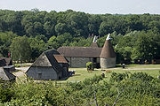
Museum of Kent Life
Encyclopedia
Kent Life is an open air museum
located at Sandling
, next to Allington
Locks on the east bank of the River Medway
.
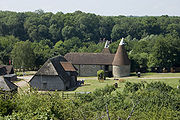 Sir Hugh Garrard Tyrwhitt-Drake bequeated the Cobtree Manor Estate to Maidstone Borough Council in 1966. A part of the estate was Sandling Farm, on the banks of the Medway. In 1984 a decision was made to restore the derelict farm as part of a rural life museum. The museum opened to the public on July 6, 1985.
Sir Hugh Garrard Tyrwhitt-Drake bequeated the Cobtree Manor Estate to Maidstone Borough Council in 1966. A part of the estate was Sandling Farm, on the banks of the Medway. In 1984 a decision was made to restore the derelict farm as part of a rural life museum. The museum opened to the public on July 6, 1985.
 A five bay barn dating from the eighteenth century and originally at Vale Farm, Calcott, near Sturry
A five bay barn dating from the eighteenth century and originally at Vale Farm, Calcott, near Sturry
. The barn has an oak
frame and a thatched roof. It was dismantled in 1984 and re-erected at the museum in 1989.
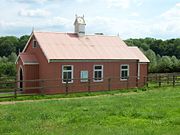 The chapel
The chapel
is a timber framed building clad in corrugated iron (a tin tabernacle
). It was originally built in 1897 in Cuxton
and was donated to the museum in 2000 when a new chapel was built.
 Originally called Old Cottage and Water Street Cottage, these cottages stood at Lenham
Originally called Old Cottage and Water Street Cottage, these cottages stood at Lenham
. The Grade II listed building were threatened by the building of the Channel Tunnel
rail link. The builder of the link offered the cottages to the museum, along with the funding for their removal and re-erection. They were dismantled in June 1999, and re-erected between January 2000 and March 2001, opening to the public in July 2001.
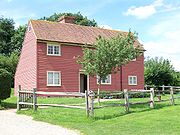 A late-eighteenth-century farmhouse. Petts Farmhouse is a Grade II* listed building.
A late-eighteenth-century farmhouse. Petts Farmhouse is a Grade II* listed building.
 Sandling farmhouse is one of the original farm buildings. It was the home of George Brundle, the last tenant of the farm until his death at 98 in 2001. The building dates to the sixteenth century, and has links to Sir Thomas Wyatt.
Sandling farmhouse is one of the original farm buildings. It was the home of George Brundle, the last tenant of the farm until his death at 98 in 2001. The building dates to the sixteenth century, and has links to Sir Thomas Wyatt.
 A nineteenth-century granary
A nineteenth-century granary
from Boxley Grange Farm, Boxley
was dismantled in March 1993 and has been re-erected at the museum.
s from North Frith Farm, Hadlow
was dismantled and re-erected at the museum. These huts are built of brick, with internal fireplaces. A set of hopper huts with a wood frame clad in corrugated iron has been constructed, along with a cookhouse and privy
.
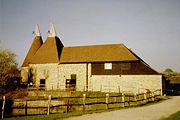 One of the original farm buildings. The oast originally had four kilns, two round and two square. Hops
One of the original farm buildings. The oast originally had four kilns, two round and two square. Hops
had last been dried here some time before 1925. The two square kilns were demolished in 1935 and the stowage was damaged in a fire in 1951. The oast was restored in 1984, both round kilns and one square kiln being restored with cowls
. The oast houses a reconstruction of a village store, being the interior fittings of a general store in Hawkhurst
.
was presented to the museum in 1994.
 Of similar construction to the chapel. The old village hall from Ulcombe
Of similar construction to the chapel. The old village hall from Ulcombe
was donated to the museum in 1997. It was dismantled in October 1997 and re-erected, opening to the public in June 2000.
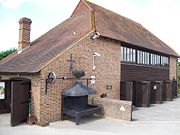 The wagon store building was purpose built at the museum in 1993. The re-created forge is at one end.
The wagon store building was purpose built at the museum in 1993. The re-created forge is at one end.
Open air museum
An open-air museum is a distinct type of museum exhibiting its collections out-of-doors. The first open-air museums were established in Scandinavia towards the end of the nineteenth century, and the concept soon spread throughout Europe and North America. Open-air museums are variously known as...
located at Sandling
Sandling, Maidstone
Sandling is a suburb to the north of the town of Maidstone, Kent, England. Within the area is the headquarters of the Kent Wildlife Trust at Tyland Barn. Beside the River Medway is an eating place called The Malta Inn. Sandling is also home to the Museum of Kent Life...
, next to Allington
Allington, Kent
Allington is an almost entirely modern village situated alongside the sides of the A20 road west of Maidstone in Kent. It is part of the built-up area of Maidstone. It has 2 primary schools; Allington Primary and Palace Wood...
Locks on the east bank of the River Medway
River Medway
The River Medway, which is almost entirely in Kent, England, flows for from just inside the West Sussex border to the point where it enters the Thames Estuary....
.
History

Farming
At the museum, various aspects of farming are recreated. There are two small hop gardens, growing Fuggles and Goldings hops. Apple and plum orchards, a herb garden, a soft fruit garden and various livestock.Buildings
The museum has a variety of buildings, most of which have been dismantled and re-erected at the museum.Barn

Sturry
Sturry is a village on the Great Stour river three miles north-east of Canterbury in Kent. The large parish of Sturry Church incorporates the former mining village of Hersden and several hamlets.-Geography:...
. The barn has an oak
Oak
An oak is a tree or shrub in the genus Quercus , of which about 600 species exist. "Oak" may also appear in the names of species in related genera, notably Lithocarpus...
frame and a thatched roof. It was dismantled in 1984 and re-erected at the museum in 1989.
Chapel

Chapel
A chapel is a building used by Christians as a place of fellowship and worship. It may be part of a larger structure or complex, such as a church, college, hospital, palace, prison or funeral home, located on board a military or commercial ship, or it may be an entirely free-standing building,...
is a timber framed building clad in corrugated iron (a tin tabernacle
Tin tabernacle
Tin tabernacles were a type of prefabricated building made from corrugated iron developed in the mid 19th century initially in Great Britain. Corrugated iron was first used for roofing in London in 1829 by Henry Robinson Palmer and the patent sold to Richard Walker who advertised "portable...
). It was originally built in 1897 in Cuxton
Cuxton
Cuxton is a village in the unitary authority of Medway. It lies on left bank of the River Medway in the North Downs. It is served by the A228, and Cuxton railway station on the Medway Valley Line between Strood and Maidstone...
and was donated to the museum in 2000 when a new chapel was built.
Lenham Cottages

Lenham
Lenham is a market village in Kent situated on the southern edge of the North Downs, halfway between Maidstone and Ashford. The picturesque square in the village has two public houses , a couple of restaurants, and a tea-room....
. The Grade II listed building were threatened by the building of the Channel Tunnel
Channel Tunnel
The Channel Tunnel is a undersea rail tunnel linking Folkestone, Kent in the United Kingdom with Coquelles, Pas-de-Calais near Calais in northern France beneath the English Channel at the Strait of Dover. At its lowest point, it is deep...
rail link. The builder of the link offered the cottages to the museum, along with the funding for their removal and re-erection. They were dismantled in June 1999, and re-erected between January 2000 and March 2001, opening to the public in July 2001.
Petts Farmhouse

Sandling Farmhouse

Granary

Granary
A granary is a storehouse for threshed grain or animal feed. In ancient or primitive granaries, pottery is the most common use of storage in these buildings. Granaries are often built above the ground to keep the stored food away from mice and other animals.-Early origins:From ancient times grain...
from Boxley Grange Farm, Boxley
Boxley
The large village and civil parish of Boxley in the Maidstone District of Kent, England lies below the slope of the North Downs, four miles NE of Maidstone town...
was dismantled in March 1993 and has been re-erected at the museum.
Hopper Huts
A set of Hopper hutHopper hut
A hopper hut was a form of temporary accommodation provided for hop-pickers on English farms in the 19th and 20th centuries.-Background:thumb|Hopper huts at Grange Farm, TonbridgeBefore the days of mechanised farming, hop picking was a labour-intensive process, requiring a vastly greater number of...
s from North Frith Farm, Hadlow
Hadlow
Hadlow is a village in the Medway valley, near Tonbridge, Kent; it is in the Tonbridge and Malling district. The Saxon name for the settlement was Haeselholte...
was dismantled and re-erected at the museum. These huts are built of brick, with internal fireplaces. A set of hopper huts with a wood frame clad in corrugated iron has been constructed, along with a cookhouse and privy
Outhouse
An outhouse is a small structure separate from a main building which often contained a simple toilet and may possibly also be used for housing animals and storage.- Terminology :...
.
Oast

Hops
Hops are the female flower clusters , of a hop species, Humulus lupulus. They are used primarily as a flavoring and stability agent in beer, to which they impart a bitter, tangy flavor, though hops are also used for various purposes in other beverages and herbal medicine...
had last been dried here some time before 1925. The two square kilns were demolished in 1935 and the stowage was damaged in a fire in 1951. The oast was restored in 1984, both round kilns and one square kiln being restored with cowls
Cowl (oast)
thumb|Cowls on a maltings at [[Ware, Hertfordshire|Ware]], Herts. A Cowl is a device used on a kiln to keep the weather out of, and induce a flow of air through, the kiln...
. The oast houses a reconstruction of a village store, being the interior fittings of a general store in Hawkhurst
Hawkhurst
Hawkhurst is a village and civil parish in the borough of Tunbridge Wells, Kent, England. The parish lies to the south-east of Tunbridge Wells. Hawkhurst itself is virtually two villages...
.
Shepherd's Hut
A shepherd's hut from Acton Farm, CharingCharing
Charing is a small village and civil parish in the Ashford District of Kent, in south-east England. The parish population is 2,750 ; it includes the settlement of Charing Heath.It is situated at the foot of the North Downs...
was presented to the museum in 1994.
Village Hall

Ulcombe
Ulcombe is a village near the town of Maidstone in Kent, England. The name has evolved from 'Owl-coomb', 'coomb' meaning 'a deep little wooded valley; a hollow in a hill side' in Old English. It stands on the Greensand Way...
was donated to the museum in 1997. It was dismantled in October 1997 and re-erected, opening to the public in June 2000.
Wagon Store

External links
- Museum of Kent Life homepage

